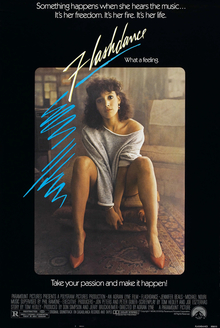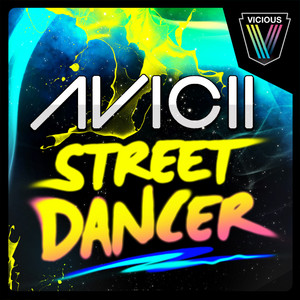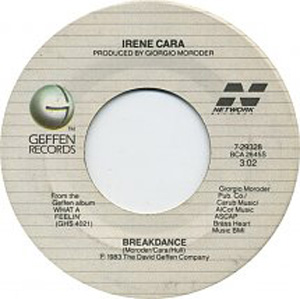Two-step or two step may refer to:

Flashdance is a 1983 American romantic drama dance film directed by Adrian Lyne and starring Jennifer Beals as a passionate young dancer who aspires to become a professional ballerina (Alex), alongside Michael Nouri playing her boyfriend and the owner of the steel mill where she works by day in Pittsburgh. It was the first collaboration of producers Don Simpson and Jerry Bruckheimer, and the presentation of some sequences in the style of music videos was an influence on other 1980s films including Footloose, Purple Rain, and Top Gun, Simpson and Bruckheimer's most famous production. It was also one of Lyne's first major film releases, building on television commercials. Alex's elaborate dance sequences were shot using body doubles.

Beat Street is a 1984 American dance drama film featuring New York City hip hop culture of the early 1980s. Set in the South Bronx, the film follows the lives of a pair of brothers and their group of friends, all of whom are devoted to various elements of early hip hop culture, including breakdancing, DJing and graffiti.
Speed is the rate of motion, change, or activity.
New Zealand hip hop derives from the wider hip hop cultural movement originating amongst African Americans in the United States. Like the parent movement, New Zealand hip hop consists of four parts: rapping, DJing, graffiti art and breakdancing. The first element of hip hop to reach New Zealand was breakdancing, which gained notoriety after the release of the 1979 movie The Warriors. The first hip hop hit single, "Rapper's Delight" by the Sugarhill Gang, became a hit in New Zealand when it was released there in 1980, a year after it was released in the United States. By the middle of the 1980s, breakdancing and graffiti art were established in urban areas like Wellington and Christchurch. By the early 1990s hip hop became a part of mainstream New Zealand culture.

Hans Hugo Harold Faltermeier is a German musician, composer and record producer.

Hip hop dance is a range of street dance styles primarily performed to hip hop music or that have evolved as part of hip hop culture. It is influenced by a wide range of styles that were created in the 1970s and made popular by dance crews in the United States. The television show Soul Train and the 1980s films Breakin', Beat Street, and Wild Style showcased these crews and dance styles in their early stages; therefore, giving hip-hop dance mainstream exposure.

Breakin' is a 1984 American breakdancing-themed musical film directed by Joel Silberg and written by Charles Parker and Allen DeBevoise based on a story by Parker, DeBevoise and Gerald Scaife.

Breakin' 2: Electric Boogaloo is a 1984 American dance musical film directed by Sam Firstenberg. It is a sequel to the 1984 breakdancing film Breakin'. Electric Boogaloo was released seven months after its predecessor by TriStar Pictures. In some international locations the film was released under the title Breakdance 2: Electric Boogaloo. Another sequel, Rappin' was made but had an unconnected plot and different lead characters – only Ice-T features in all three films.

Breaking, also called breakdancing or b-boying/b-girling, is an athletic style of street dance originating from the African American community in the United States. While diverse in the amount of variation available in the dance, breakdancing mainly consists of four kinds of movement: toprock, downrock, power moves and freezes. Breakdancing is typically set to songs containing drum breaks, especially in hip-hop, funk, soul music and breakbeat music, although modern trends allow for much wider varieties of music along certain ranges of tempo and beat patterns.
The System is an American synth-pop duo that debuted in the 1980s, composed of vocalist-guitarist Mic Murphy and seasoned session keyboardist David Frank. The band was founded in 1982 in New York and backed up by Paul Pesco on electric guitar and Kris Khellow on keyboards and synthesizers. The group is sometimes referred to as being "emotio-electro" because of its hi-tech, synthesizer-driven sound, married with passionate vocals and sensitive lyrics.

Breakdance is an amusement ride designed by Huss Maschinenfabrik GmbH & Co. KG in 1985.
Breaking or breakin' may refer to:

The history of hip-hop dances encompasses the people and events since the late 1960s that have contributed to the development of early hip-hop dance styles, such as uprock, breaking, locking, roboting, boogaloo, and popping. African Americans created uprock and breaking in New York City. African Americans in California created locking, roboting, boogaloo, and popping—collectively referred to as the funk styles. All of these dance styles are different stylistically. They share common ground in their street origins and in their improvisational nature of hip hop.

"Street Dancer" is a song by Swedish house producer and DJ Avicii. It was released on 17 January 2011 in South Africa, 26 February 2011 in the Netherlands, 29 March 2011 in the US, and on 5 June 2011 in the UK. It was written by Avicii and samples the Break Machine's 1983 breakdance hit "Street Dance".
Street dance, formally known as vernacular dance, refers to dance styles that evolved outside of dance studios in any available open space.
Punchdance refers to a form of street dance involving punching in the form of shadowboxing as well as other combat maneuvers to a rhythm.

"Breakdance" is a song written by Giorgio Moroder, Bunny Hull, and the song's performer, Irene Cara. Moroder's obsession with the dance hit "Rockit" by Herbie Hancock fueled his composition of the music, and Cara was inspired by the street performers she saw growing up in the South Bronx to write lyrics about what was then called breakdancing. Released in March 1984, it was the third single that originated on her What a Feelin' LP and her first to make the top ten in the US since the album's title track went to number one almost a year earlier. "Breakdance" also charted in several other countries and had a dance remix that was also well received.
Hip-Hop has been around in Mauritius since it has been on International media. Each generation has their own preference in terms of Rap Artists, but all artists who have been playing on the medias since TuPac have also been aired in Mauritius.

"Aku Raukura", also known as "Raukura", is a song by Pātea Māori Club. Originally written in sessions with Ngoi Pēwhairangi and Dalvanius Prime in Tokomaru Bay in 1982, it was released as their second single in June 1984, during the chart success of their debut hit "Poi E". The song peaked at number 10 in New Zealand, and was later included in their 1987 debut album Poi E.











